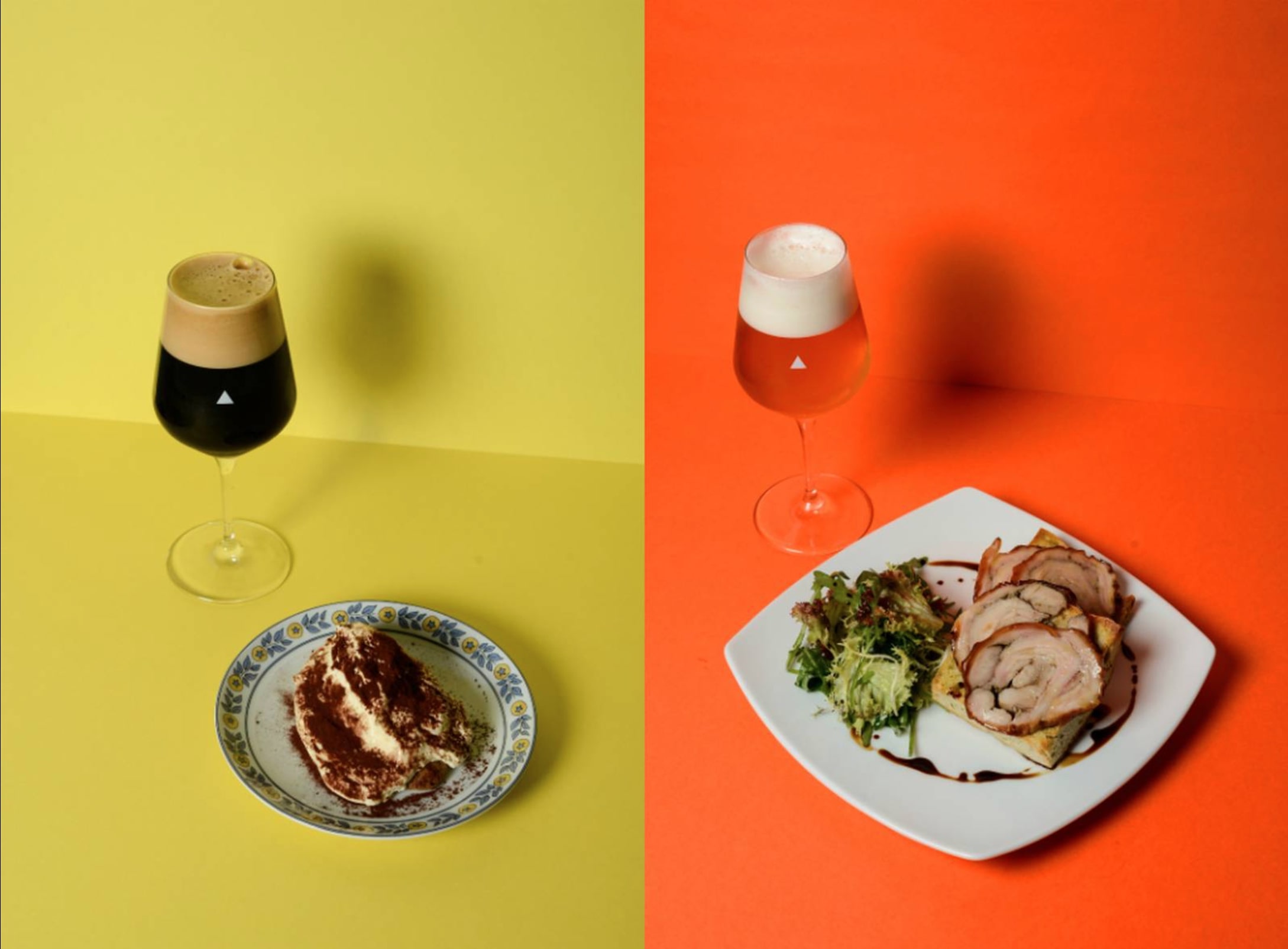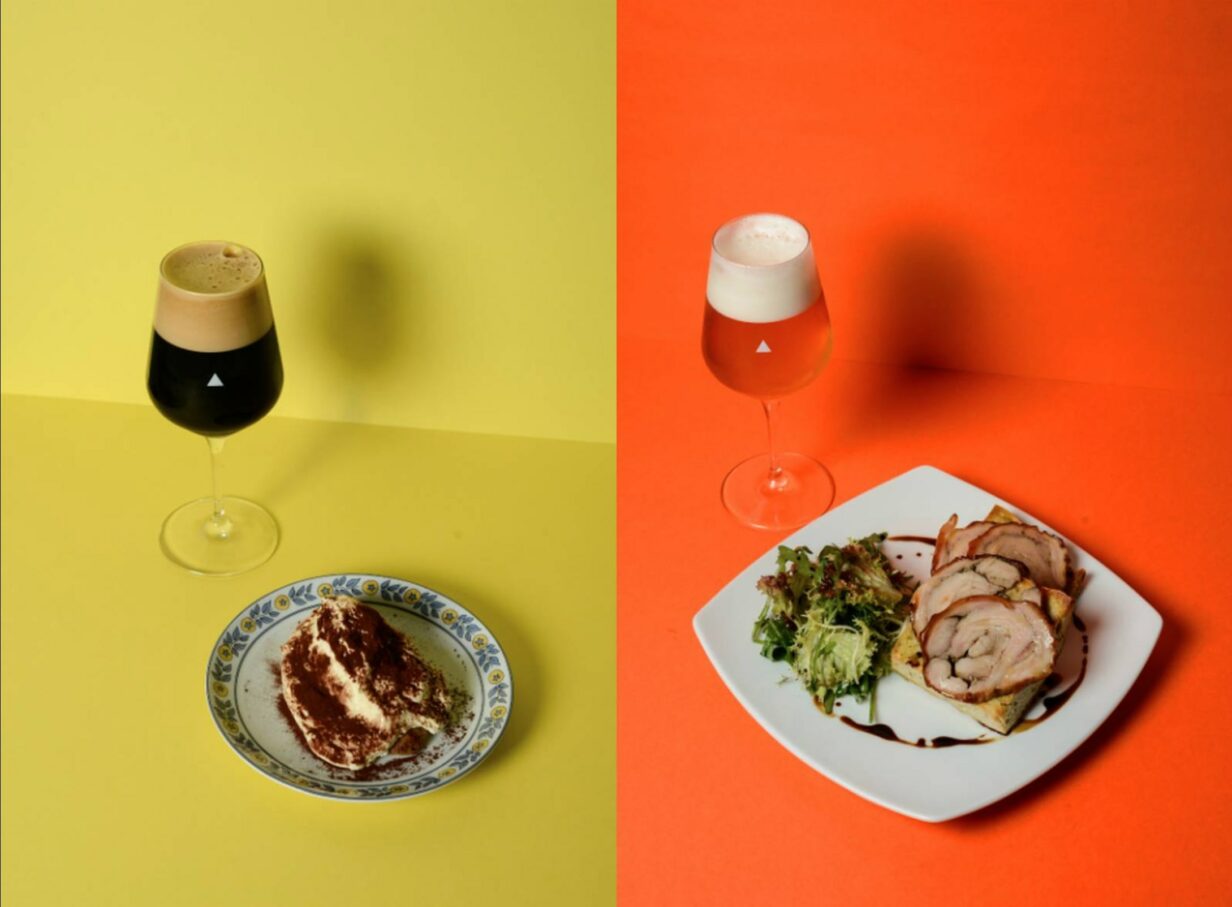The faultless agreements of professionals
Food artisans reveal their ideal combinations of beer and food.

Mehdi Kamel-Parailloux Barman, mixologist "I've never seen a competition that imposed beer".
Mehdi Kamel-Parailloux is a cocktail artist. Between his paws, making the most ordinary Long Island cocktail becomes an aerial spectacle. Halfway between circus juggler and mixology expert, the 25-year-old is a flair bartender. Translation: behind his counter, he grabs the shakers, the bottles of alcohol and the spoons, and waltzes the whole thing through the air to give birth to a fruity or creamy cocktail. Now the bat of the Parisian night, Mehdi Kamel-Parailloux was also an amateur rugby player. It's impossible for him not to associate the bitterness of beer with third halves. "It's the clubhouse, the mates, Sunday afternoons," he says with a smile.
He came third in the French Flair Bartending Championship in November, and regrets: "I've never seen a cocktail competition that required beer as a basic element." He has already thought of a few combinations: "Cider, beer and peach syrup can go very well together. Or a beer with almond liqueur and orange juice."
But the ultimate is the mojito revisited, invented by a freedom-loving bartender. Using ten mint leaves and half a lemon cut into quarters, add a little chilli syrup, then crush it all together. Then fill the glass with ice cubes (also crushed). Pour in the rum. Shake with a spoon (a bar spoon, of course) and top up with a light beer like Desperados.
Hugo Desnoyer butcher "Today, you can find very high-end products".
"Beer is refreshing, and it doesn't hit as hard as wine," enthuses Hugo Desnoyer (1), a leading figure in traditional butchery in Paris. Today, you can find top-of-the-range, beautiful products that offer a wide range of tastes. Not to mention the pleasure of the gesture and the tasting." However, the ace cutter doesn't offer any of these noble beers at his table d'hôtes, adjacent to his butcher's shop. For a time, a bottle of craft beer from the Vézelay brewery in Burgundy had the privilege of appearing on the menu, "but people only wanted wine". A question of education, he says. On the other hand, there's no doubt that blondes and brunettes will have pride of place in his new boutique, due to open in April in Japan, "a country with a beer culture". " Brought up on cider", the artisan from Mayenne doesn't hesitate to "play" with beer in his recipes. In his sweetbreads, for example, which he colors in a pan, sprinkles with shallots and deglazes with a marked beer, "a rousse or something strong", before adding roasted, crushed peanuts. A festive dish that can be enjoyed with a white wine. Or in his guinea fowl, swaddled in smoked breast surrounded by whole shallots for confit and minced fennel, which he cooks in a casserole in a white beer. To be enjoyed with a red wine. Another suggestion: beef tartare with a beer and soy sauce reduction, served with Cremona mustard and a beer with a hint of bitterness.
Romain Olivierfromager "A third taste must appear".
"My region produces a wine that foams, made from hops. It's called beer." The stage is set. In Boulogne-sur-Mer (Pas-de-Calais), Romain Olivier has always combined his best products with the region's most popular beverage. The Olivier family have been ripeners and cheese merchants since 1907 (1). Their belief: "It's hard to make mistakes when mixing beverages from one region with products from the same place." Indeed, vieux-boulogne, a soft cheese made from raw cow's milk, has always been brushed with a solution of water, salt and craft beer. For a successful combination, the equation is simple: "It has to be 1 + 1 = 3. The cheese itself provides the taste. Behind it, the sip of beer brings another. By combining the two in the mouth, a third taste must appear." According to the professional, to provoke this synergy, there's nothing better than a Crémet du Cap Blanc Nez, or a chaource with a lightly lemony white beer. " In this case, the play of acidity is very interesting", he adds. With a very light blonde or amber, old Comté cheese shavings or a very old Mimolette will make a fine blend to slip under the palate. For amber wines, there's nothing better than a soft cheese with a raised rind. Like maroilles, coeur d'Arras, saint-rémois or munster. " Neither should be overpowered," warns Romain Olivier. To round off the meal, a good brown sugar waffle accompanied by a light beer is a must.
Christine Ferber pâtissière "A sabayon with a spring beer".
Christine Ferber (1), pastry chef, chocolatier and confectioner, drank her first and most important sips of beer in Brussels, where she learned her trade. Her favorite at the time: lambic, a spontaneously fermented beer "very sweet and fruity that drinks like lemonade, but beware of the backlash!" Since then, the "queen of jams", listed in the capital's most prestigious boutiques, has returned to her native Alsace, a "region where hops have always been planted and where there's no shortage of craft beers".
In Niedermorschwihr (Haut-Rhin), the small village where she practices her art, the beverage sometimes invites itself into her cauldron. "When it's mixed with apple, its harshness offers a lovely blend with the sweetness of the fruit." In his kitchen, beer can also be used to make a sabayon. "Made with a spring beer, it's perfect for topping a rhubarb and strawberry gratin passed through a salamander sauce." And why not opt for a beer to accompany end-of-year pastries? "You can choose a spicy beer with a dark or milk chocolate bavarois, but we'd rather opt for a sweeter, lemony-flavored beer with a cake with exotic notes." The same advice applies to a house specialty, the "Colette passion", a dacquoise filled with fruit mousseline cream, topped with a dome of pineapple sticks and diced mango. Another of Christine Ferber's ideas for the festive season is a beer sorbet: "Lightly lemony, served in a glass and washed down with a mild beer, it makes an ideal trou normand."
Gilles Vérot charcutier "Rustic products go well with it".
At first, Gilles Vérot (1), a traditional charcutier with a presence in Paris, London and New York, wasn't " too keen" on the idea of entrusting his hams on the bone, head pâtés and other sausages to the charms of mousse. Not "very knowledgeable about beer", the man, a rising star of the cochonnaille scene who is heard even in the amphitheaters of Sciences-Po where he gives lectures on business strategy, is more enamored of wine. " But rather rustic products go rather well with beer", he concedes. Starting with "sauerkraut, the dish of December and cold weather", which is "an obvious choice", followed closely by dry sausage, terrines and pâtés de campagne. Then he got more daring, proposing to marry his poultry and pistachio pâté with a blond beer, or his black Bigorre pork terrine, "powerful in taste", with an amber beer. Unless, of course, the latter is a perfect match for a grouse and quince terrine. And for a white? A galantine of duck with foie gras could be just the thing. As would a plate of snails. Beer goes well with powerful products," explains Gilles Vérot. It's not a question of nobility, but with products that are too fine, there's a risk that it will break the taste by taking over the palate." He concludes that the aperitif remains the ideal moment to bring together beers and charcuterie, inviting dry sausages, andouillettes and greniers médocains to the table.
Jocelyn Bérubé Brewer "An almost infinite palette of flavors".
It all started with a mug of Belgian beer sipped at the age of 16 in a Quebec bar," says Jocelyn Bérubé, now a brewer. The Canadian self-taught his craft in Montreal. It's also where he met his wife, Maily Malfreyt, who introduced him to her brother, Laurent Malfreyt, a French chef. Together, they discovered California, a temple of craft beer, and forged a common dream: to open a restaurant featuring food and beer pairings. But not just any beers: craft beers "made with love and 100% natural ingredients". For the past two months, in Paris's 10th arrondissement, their restaurant, Le Triangle (1), has been offering eight draught beers from all over the world, and will soon be offering in-house brewed beers. It's at the table that the three friends dip into this "almost infinite palette of tastes" to find some nice surprises. Served as demi or galopin, "to taste without getting drunk", beer is part of every dish, including those for the holidays. Their ideal New Year's Eve meal? Salmon gravlax with horseradish sauce, served with Calypso, a light, tangy, citrusy beer made in England. Then, a filet of Rossini beef, pan-fried foie gras and Darphin apple, served with a malty, caramelized brune. Not forgetting the traditional Brie de Meaux stuffed with truffles and mascarpone, sublimated by a Brooklyn Sorachi Ace, an American beer brewed from Japanese hops. Finishing with a tiramisu accompanied by a black coffee beer.
Patrick Roger chocolatier "Cacao et houblon, union du feu de Dieu" (Cocoa and hops, a union of God's fire)
At 46, Patrick Roger insists he's never been drunk. His only excess? Chocolates, which he can gobble up in batches of 50, 60 or 100. When he goes to the bistro, he orders water, never alcohol. The chocolatier (1) is by no means a barfly, but he is the creator of Hypoxie, a beer-flavored chocolate about which he speaks greedily. "It's sublime. It works like a charm, this alliance," he says of the marriage of the love of his life, chocolate, with hops.
Directed by Libération
Discover another article


